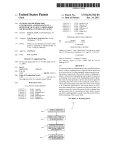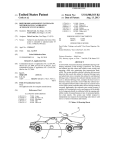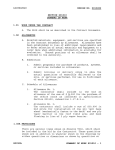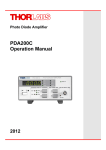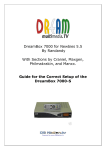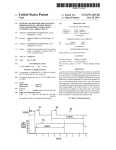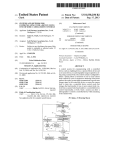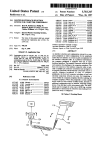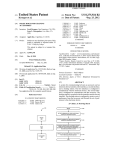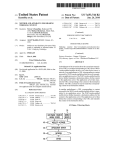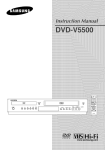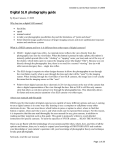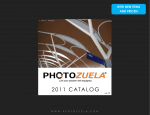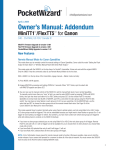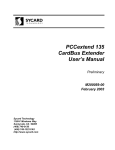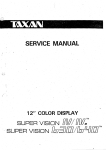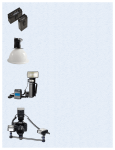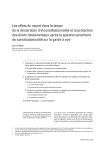Download VOLTAGE EW\1—1 Ti `Zw
Transcript
US008326136B1
(12) Ulllted States Patent
(10) Patent N0.:
Clark
(54)
(45) Date of Patent:
SYSTEMS AND METHODS FOR
3,810,214 A
5/1974 Malone et a1.
2
ONE OR MORE CAMERA BODY CONTROLS
4,333,719 A
4,344,680 A
@1982 Takami et 31‘
8/1982 I h'da t l.
4,355,309 A
10/1982 Hughey et a1.
Continued
a
geek t l
a
3.113. e
4,351,594 A
(US)
(
Burlington, VT (US)
Notice:
Subject to any disclaimer, the term of this
CN
2007800204204
OTHER PUBLICATIONS
Appl' No‘: 12/705096
F11 e d :
Fe b . 12 , 2010
Affadavit of James E. Clark: FlashWiZard II Synchronizer, signed
Mar. 20, 2008; previously submitted in US. Appl. No. 11/697,241.
(Continued)
Related US. Application Data
(60) Provisional application No. 61/151,881, ?led on Feb.
12, 2009'
(58)
Prlrflary Examliqer i Clayton E LaBane
ASSlSZLlI’lZ Examiner * Leon W Rhodes, Jr.
(74) Attorney, Agent, or Firm * DoWns Rachlin Martin
Int. Cl.
G03B 15/02
G03B 15/05
U . S . Cl .
_ 6/2010
(comlnued)
U.S.C. 154(b) by 300 days.
52
)
FOREIGN PATENT DOCUMENTS
patent is extended or adjusted under 35
(51)
a .
9/1982 lzhfda :1 :1,
(73) Assignee: Lab Partners Associates, Inc., South
(21)
(22)
Dec. 4, 2012
COMMUNICATING WITH A DEVICE USING
(75) Inventor: James E. Clark, South Burlington, VT
(*)
US 8,326,136 B1
PLLC
(2006.01)
(2006.01)
............. ..
(57)
396/56 ; 396/4 ; 396/164 ; 396/299
Field of Classi?cation Search ................ .. 396/15
A
ABSTRACT
contro l
s y stem
for
'
' g Wit
' h a
communlcatin
contro 11 e d
device. such as a lighting device, a special effects device and
396/56i58, 166, 175, 201, 280, 299, 3014303,
an in-scene device, in a photographic image-acquisition set
34833313
ting using a camera body. The control system is con?gured to
See application ?le for complete Search history,
detect a preset pattern of actuation of one or more camera
body controls by a user. In response to detecting of the preset
R e ferences C'Ite d
p attern,t h econtro l s y stem e1t
' h er commumcates
'
a p oWer state
56
U.S. PATENT DOCUMENTS
3,039,375 A
3,185,056 A
3,205,803 A
6/1962 Umbach
5/1965 Gold et a1.
9/1965 Burgarella et a1.
3,259,042 A
RE26,627 E
7/1966 Kagan
7/1969 Burgarella et a1.
3,659,509 A
5/1972 Burgarella
3,728,947 A
3,782,258 A
4/1973 Harnden et a1.
1/1974 Boekkooi et a1.
change signal to the controlled device or causes the camera
body to enter into a controlled device control mode that
changes the functionality of one or more camera body con
trols from a camera body functionality to a controlled device
control functionality, or both. Such a system can alloW a
photographer to control a controlled device While remaining
at the camera body.
46 Claims, 13 Drawing Sheets
DE'I'PCT A PRESET PATTERN OF
ACI'UAT'IUN BY A USER OF ONE OR
105 f
MORE CAMERA BODY CONTROLS
GENERA'I'E A POWER STATE CHANGE
SIGNAL IN RESPONSE TO DETECT ION
110
OF THE PRESET PATTERN
604
COMMUNICATE THBPOWER
f STATE CHANGE SIGNAL To THE M
115
mm: ONE DEVICE so THAT T‘Hl:
AT LEAST ONE DEVICE OPERATES
608
VOLTAGE EW\1—1
Ti
AT A FIRST Powwg sum;
100
LIGHT 5g
OUTPUT e0
DETHCT A PRESET PATTERN OF
ACTUA'HON Ev A USER OII ONE OR
120 /
125/
‘ MORE CAMERA BODY CONTROLS
GENEMTE A POWER STATE CHANGE
SIGNAL 1N RESPONSE TO DE'I‘ECTION
UP THE PRESET PATTERN
COMMUNICA ‘[1 THE POWER
f STATE CHANGE 510mm To THE AT
W,
LEAS'! ONE DEVICE so THAT THE
AT LEAST our. DEVICE OPERATES
AT A SECOND POWER STATE
1% MAX) ,0
/
20
0
:
/
'Zw
US 8,326,136 B1
Page2
US. PATENT DOCUMENTS
.
4,482,895
4,509,845
4,571,049
4,573,786
4,603,954
A
A
A
A
A
11/1984
‘"1985
2/1986
3/1986
8/1986
2003/0128272 A1
2003/0133018 A1
W‘FmbGTg.
M12099.“
Tsunefujletal.
Tamguch‘ et a1~
Egawa 6‘ a1~
2003/0193588
2004/0036774
Zoos/0006484
2005/0174434
2006/0014563
A1
A1
Al
A1
A1
7/2003 Clough et a1.
7/2003
ZiernkoWski
10/2003
2/2004
M2005
8/2005
1/2006
Yuen etal.
Nichols et al.
Ito
Chang etal.
Cheng
4,636,052 A
V1987 BOWSh‘FT
2006/0216009 A1*
4,643,551 A
“987 Ohmon
2006/0275024 A1
12/2006 McNary
3,323,332‘ A
‘9632; lg?wamm et a1~
2006/0291016 A1
12/2006 Ishigamietal.
4,816,850 A
M989 phfllilpzaux et a1
2008/0065137 A1
3/2008 Borlcheretal.
2008/0065139 A1
3/2008
’
’
.
'
9/2006 KaWarnura .................... .. 396/55
Scr1bner et al.
4,816,855 A
3/1989 KTtauraetal.
2009/0l29765 Al
4,884,094 A
4,988,584 A
11/1989 Kltaum ‘ital
V1991 ShaPer .
2009/0135262 A1
2009/0278479 A1
5/2009 OgasaWara
11/2009 Platneretal.
5/2009 King
2009/0310012 A1*
12/2009 Ueda etal. .................. .. 348/348
5,016,037 A
5/1991 Taniguchi et a1~
5,159,375 A
10/1992 Tan1g1_1ch1etal.
20l0/0158494 A1
600“) King
5,283,610 A
5,299,012 A
“994 Sasak‘
3/1994 Tsurutaetal.
2010/0202767 A1
20l0/0209089 Al
8/2010 ShirakaWa
80010 King
?zz/2g:
“M332 (T3191? 1
2011/0001665 A1
1/2011 King
5,422,543 A
M995 vagll?féra'
2011/0119409 A1
5/2011 King
’
’
.
5,436,531 A
g
2011/0123185 A1
5/2011
7/1995 Wemberg
2011/0128390 A1
6/2011 Clark
c1ai1<
5,521,708 A
5,640,623 A
5,692,223 A
5/1996 Beret‘?
6/1997 sasflkl
11/1997 Ic_h1kaWaet al.
2011/0129207 A1
2011/0167008 A1
2012/0027395 A1
6/2011 King etal.
7/2011 King
2000 Clark
5,708,833 A
5,721,971 A
V1998 Klnney 6‘ a1~
2/1998 Sasakl
2012/0099847 A1
4/2012 Clark
5,734,934 A *
2012/0127361 A1
5/2012 Clark
3/1998 nglnnishieial. ............. .. 396/62
20120140088 A1
6/2012 Clark
2012/0148221 A1
6/2012 Clark
253,232
6,006,039
6,029,013
6,052,539
6,088,542
6,127,940
6,167,199
6,278,481
6,351,610
6,353,711
6,366,737
6,400,907
A
A
A
A
A
A
A
A
B1
B1
B1
B1
B1
6,404,987 B1*
@1332 151110220
12/ 1999 Steinberg et a1.
2/2000 Laikin etal.
4/2000 Latorre
7/2000 Yanaietal.
10/2000 Weinberg
12/2000 Fukui
8/2001 Schmidt
2/2002
3/2002
4/2002
6/2002
Numako etal.
Numako etal.
Numako etal.
IZukaWa
6/2002 Fukui ............................ .. 396/56
FOREIGN PATENT DOCUMENTS
CN
EP
20l0-l0600736.4
0984320 A1
EP
EP
EP
077602639
077602639
87564589
EP
EP
EP
JP
111779955
111779971
111779955
56443422
1/2011
7/2011
7/2011
12/2011
12/2011
7/2012
11/1981
59-064821 A
4/1984
6,430,369
6,453,154
6,524,237
6,618,557
6,625,399
6,683,654
6,718,135
6,731,952
6,748,165
6,778,764
6,798,986
6,941,067
7,016,603
7,035,534
7,133,607
B2
B1
B1
B1
B1
B1
B2
B2
B2
B2
B2
B2
B2
B2
B2
8/2002
9/2002
2/2003
9/2003
9/2003
1/2004
4/2004
5/2004
6/2004
8/2004
9/2004
9/2005
3/2006
400%
11/2006
Lee etal.
Haber et al.
McGoWan
Ziernkowski
Davis
Haijima
Kawasaki etal.
Schaefferetal.
OgasaWara
Barghinietal.
Hagiuda
Muramatsu
Clark
Shih et ,1,
Clark
JP
59470822
JP
63-018874
JP
05-093948
JP
2002444193 A
JP
2002318413
JP
2003472970 A
JP
2003325451
JP
2004972230
JP
2006449935
JP
2007-067870 A
KR
10-0728117
W0
9638925
WO PCT/US2003/3727l
WO PCT/US2007/066162
WO PCT/US2006/028229
9/1984
1/1988
4/1993
8/2002
10/2002
6/2003
11/2003
3/2004
6/2006
3/2007
6/2007
12/1996
5/2004
11/2007
2/2008
7,184,658
7,362,965
7,437,063
7,463,304
7,702,228
7,764,875
7,775,575
7,783,188
7,877,005
7,880,761
7,885,533
7,965,335
B2
B2
B2
B2
B2
B2
B2
B2
B2
B2
B2
B2
2/2007
4/2008
10/2008
12/2008
4/2010
7/2010
8/2010
8/2010
V2011
2/2011
2/2011
6/2011
squillace
Clark
Clark
Murray
Clark
Clark
Clark
Clark
Okubo
Clark
Clark
Niblock
WO
WO
WO
WO
WO
WO
WO
WO
W0
WO
WO
9/2008
9/2008
7/2010
8/2010
8/2010
8/2010
9/2010
9/2010
11/2011
l/20l2
6/2012
7,969,504 B2*
6/2011
7,970,267 B1
8,116,620 B2
6/2011 Clark
2/2012 King
gig/2251; g;
51111‘?
8’l80’2l0 B2
50012 clgk
200l/b042’l49 A1
2002/0009296 A1
2002/0067425 A1
2002/ 0067923 A1
Matsuda et al. ............ .. 348/371
110001 Ito et a1‘
1/2002 Shaperetal.
6/2002 Iverson
6/ 2002 Fujimura
JP
2/2012
3/2000
PCT/US2008/065l37
PcT/Us2008/065139
PCT/US20l0/024088
2010093914
2010093927
2010093994
PCT/US20l0/024l08
PCT/US20l0/024l95
PcT/Us2011/044008
2012009537
PCT/US20l2/0259l5
Al
A1
Al
Al
OTHER PUBLICATIONS
Analog Devices Technical Data Sheet for ADF7020-1 Transceiver
10, Analog Devices, Inc., 2005,pp. 1-44.
ASH Transceiver Impedance Matching; Document Created on Dec.
10, 2001; pp. 1 to 10; http://WWW.rfm.corn/products/apnotes/anten
namatchpdf;lastvlewedonDeo15,2005.
Canon EOS 40D Usuer’s Manual; about Sep. 2007; Canon Corpo
ration.
US 8,326,136 B1
Page 3
Declaration of James E. Clark ?led Feb. 18, 2005 in US. Appl. No.
U.S.Appl. No. 10/306,759,Apr. 14, 2005, Response to Of?ceAction,
10/ 306,759.
now US. Pat. No. 7,016,603.
Ken Rockwell; How to Use Nikon Strobes Wirelessly, for Free! ; Dec.
US. Appl. No. 10/306,759, Jun. 29, 2005, Final Of?ce Action, now
US. Pat. No. 7,016,603.
17, 2005; http://web.archive.org/web/20051217091704/http://www.
kenrockwell.com/nikon/ittlslave.htrn; last viewed at Internet archive
on Apr. 1, 2010.
US. Appl. No. 10/306,759, Aug. 25, 2005, Response to Final Of?ce
Nikon D2x; Sep. 2004; pp. 1 to 12; Nikon Corporation.
U.S.Appl.No. 10/306,759, Sep. 16, 2005,Notice ofAllowance, now
Nikon WT-l Transmitter User’s Manual; around Dec. 2003; Nikon
Nikon WT-2 Article, Part 1; Nikon Corporation; http://nikonimaging.
US. Pat. No. 7,016,603.
US. Appl. No. 10/306,759, Oct. 18, 2005, 312 Amendment, now
US. Pat. No. 7,016,603.
com/global/technology/scene/1 1/index.htm; last viewed on Mar. 14,
US. Appl. No. 10/306,759, Dec. 20, 2005, Response to 312 Amend
Corporation.
Action, now US. Pat. No. 7,016,603.
2008.
ment, now US. Pat. No. 7,016,603.
Nikon WT-2 Article, Part 2: Nikon Corporation; http://nikonimaging.
US. Appl. No. 10/306,759, Jan. 4, 2006, Response to 312 Amend
com/global/technology/scene/11/indexi02.htm; last viewed on
Mar. 14, 2008.
US. Appl. No. 10/306,759, Nov. 18, 2006, Certi?cate ofCorrection,
Phil Askey, Nikon D2H Review: 15. Wireless: Digital Photography
Review, Wireless (Review of WT-l Transmitter); Dec. 2003; http://
ment, now US. Pat. No. 7,016,603.
now US. Pat. No. 7,016,603.
www.dpreview.com/reviews/NikonD2H/page15.asp; last viewed on
Mar. 18, 2008.
US. Appl. No. 11/305,668, Mar. 8, 2006, Of?ce Action, now US.
Pat. No. 7,133,607.
US. Appl. No. 11/305,668, Jun. 8, 2006, Response to Of?ce Action,
Phil Askey, Nikon D2H Review: 1. Introduction: Digital Photogra
phy Review, Nikon D2H Review, Dec. 2003; http://www.dpreview.
U.S.Appl. No. 11/305,668, Jun. 13, 2006, Supplemental Response to
com/reviews/NikonD2H/; last viewed on Mar. 18, 2008.
Request for Clari?cation by the Examiner, now US. Pat. No.
Phil Askey, Nikon D2Hs Preview: 1. Introduction: Digital Photogra
phy Review (includes Review of WT-2 Transmitter); Feb. 2005;
http://www.dpreview.com/articles/nikond2hs/; last viewed Mar. 14,
now US. Pat. No. 7,133,607.
7,133,607.
2008.
US. Appl. No. 11/305,668, Jun. 30, 2006, Notice ofAllowance, now
US. Pat. No. 7,133,607.
US. Appl. No. 11/305,668, Mar. 29, 2007, Request for Correction of
PocketWiZard MuItiMAX Transceiver New Trigger Control Soft
ware Features, by LPA Design, pp. 1 to 6, United States.
PocketWiZard MuItiMAX Transceiver Owner’s Manual, by LPA
Design, May 2001, pp. 1-55 and “Relay Mode” on p. 40, United
US. Appl. No. 11/529,203, Aug. 14, 2007, Of?ce Action, now US.
Pat. No. 7,362,965.
U.S.Appl. No. 11/529,203, Oct. 16, 2007, Terminal Disclaimer, now
Letters Patent, now US. Pat. No. 7,133,607.
States.
US. Pat. No. 7,362,965.
Quantum FreeWire Transceiver; Jul. 17, 2005; pp. 1 to 7; http://web.
US. Appl. No. 11/529,203, Oct. 16, 2007, Response to Of?ceAction,
archive.org/web/20050717015832/http://www.qtm.com/wireless/
now US. Pat. No. 7,362,965.
freewirehtml; last viewed at Internet Archive on Apr. 25, 2008.
Quantum FreeWire Transceiver; Nov. 15, 2004; pp. 1 to 7; http://web.
US. Appl. No. 11/529,203, Oct. 25, 2007, Terminal Disclaimer, now
archive.org/web/20041115093657/http://www.qtm.com/wireless/
freewirehtml; last viewed at Internet Archive on Apr. 25, 2008.
Quantum FreeWire Transceiver; Oct. 7, 2001; pp. 1 to 6; http://web.
archive.org/web/20011007140624/http://www.qtm.com/wireless/
freewirehtml; last viewed at Internet Archive on Apr. 25, 2008.
Rob Galbraith; Casting Light on the PocketWiZard MiniTT1 and
FlexTT5; Parts 1 to 5; Feb. 16, 2009; http://www.robgalbraith.com/
bins/multiipage.asp?cid:7-9884-9903; last viewed on Jul. 12,
2012.
Robert Hanashiro; Equipment CorneriNews & Notes for all Those
Gear-Heads; Nov. 26, 2001; pp. 1 to 3; http://www.sportsshooter.
com/newsistory.html?id:594; last viewed on Sep. 17, 2002.
Strobist Blog: PocketWiZard FIexTT5 and MiniTT1: Full Review;
Feb. 16 to 18, 2009; blog comments, pp. 1 to 40; http://strobist.
US. Pat. No. 7,362,965.
US. Appl. No. 11/529,203, Dec. 14, 2007, Notice ofAllowance, now
US. Pat. No. 7,362,965.
US. Appl. No. 12/104,950, Dec. 31, 2009, Of?ce Action, now US.
Pat. No. 7,764,875.
US. Appl. No. 12/104,950, Feb. 1, 2010, Response to Of?ce Action,
now US. Pat. No. 7,764,875.
US. Appl. No. 12/104,950, Mar. 23, 2010, Notice ofAllowance, now
US. Pat. No. 7,764,875.
US. Appl. No. 12/843,254, Jul. 27, 2010, Preliminary Remarks, now
US. Pat. No. 8,121,468.
US. Appl. No. 12/843,254, Aug. 25, 2011, Of?ce Action, now US.
Pat. No. 8,121,468.
US. Appl. No. 12/843,254, Aug. 25, 2011, Response to Of?ce
Action, now US. Pat. No. 8,121,468.
blogspot.com/2009/02/pocketwiZard-?extt5-and-minitt1-full.html;
US. Appl. No. 12/843,254, Aug. 25, 201 1, Terminal Disclaimer, now
last viewed on Feb. 18, 2009.
US. Appl. No. 10/306,759, Aug. 29, 2003, Of?ce Action, now US.
Pat. No. 7,016,603.
US. Appl. No. 10/306,759, Dec. 18, 2003, Response to Of?ce
US. Pat. No. 8,121,468.
US. Appl. No. 12/843,254, Nov. 28, 2011, Notice ofAllowance, now
US. Pat. No. 8,121,468.
US. Appl. No. 13/399,333, Jun. 14, 2012, Of?ce Action.
U.S. Appl. No. 11/488,491, Oct. 16, 2007, Of?ce Action.
U.S. Appl. No. 11/490,322, Apr. 20, 2010, Of?ce Action, now US.
Pat. No. 7,880,761.
US. Appl. No. 11/490,322, Jul. 12, 2010, Response to Of?ce Action,
Action, now US. Pat. No. 7,016,603.
now US. Pat. No. 7,880,761.
Strobist Blog: PocketWiZard FIexTT5 and MiniTT1: Full Review;
Feb. 16, 2009; pp. 1 to 11; http://strobist.blogspot.com/2009/02/
pocketwiZard-?extt5 -and-minitt1-full.html; last viewed on Feb. 18,
2009.
US. Appl. No. 10/306,759, Dec. 24, 2003, Examiner Interview Sum
US. Appl. No. 11/490,322, Sep. 15, 2010, Notice ofAllowance, now
mary, now US. Pat. No. 7,016,603.
US. Appl. No. 10/306,759, Mar. 27, 2004, Final Of?ce Action, now
US. Pat. No. 7,016,603.
US. Pat. No. 7,880,761.
US. Appl. No. 11/697,241, Nov. 8, 2007, Of?ce Action, now US.
Pat. No. 7,437,063.
US. Appl. No. 10/306,759, Apr. 15, 2004, Examiner Interview Sum
US. Appl. No. 11/697,241, Mar. 10, 2008, Response to Of?ce
mary, now US. Pat. No. 7,016,603.
Action, now US. Pat. No. 7,437,063.
US. Appl. No. 10/306,759, Apr. 20, 2004, Response to Final Of?ce
US. Appl. No. 11/697,241, Mar. 24, 2008, Examiner Interview Sum
Action, now US. Pat. No. 7,016,603.
mary, now US. Pat. No. 7,437,063.
US. Appl. No. 10/306,759, Aug. 24, 2004, Of?ce Action, now US.
Pat. No. 7,016,603.
US. Appl. No. 10/306,759, Feb. 18, 2005, Request for Continued
US. Appl. No. 11/697,241, Jun. 9, 2008, Notice ofAllowance, now
US. Pat. No. 7,437,063.
US. Appl. No. 12/250,914, Jun. 12, 2009, Of?ce Action, now US.
Pat. No. 7,702,228.
US. Appl. No. 12/250,914, Jun. 29, 2009, Response to Of?ce Action
Examination, now US. Pat. No. 7,016,603.
US. Appl. No. 10/306,759, Mar. 29, 2005, Of?ce Action, now US.
Pat. No. 7,016,603.
and Terminal Disclaimer, now US. Pat. No. 7,702,228.
US 8,326,136 B1
Page 4
US. Appl. No. 12/250,914, Oct. 28, 2009, Terminal Disclaimer, now
US. Pat. No. 7,702,228.
US. Appl. No. 12/250,914, Dec. 3, 2009, Notice ofAllowance, now
US. Pat. No. 7,702,228.
US. Appl. No. 12/762,811, Dec. 28, 2010, Of?ce Action, now US.
Pat. No. 7,970,267.
U.S.
US. Appl. No. 12/762,811, Mar. 28, 2011, Response to Of?ce
US.
Action, now US. Pat. No. 7,970,267.
7,764,875.
US. Appl. No. 12/762,811, Mar. 28, 201 1, Terminal Disclaimer, now
US. Pat. No. 7,970,267.
US. Appl. No. 12/762,81 1, Apr. 20, 201 1, Notice ofAllowance, now
US. Pat. No. 7,970,267.
US. Appl. No. 13/169,413, Dec. 20, 2011, Of?ce Action, now US.
Pat. No. 8,180,210.
US. Appl. No. 13/169,413, Jan. 16, 2012, Response to Of?ceAction,
now US. Pat. No. 8,180,210.
Appl .
US.
Appl .
US.
Appl .
US.
Appl. No. 12/104,950, ?led Apr. 17, 2008, now US.
Appl .
Pat .
No.
No. 12/843,254, ?led Jul. 26, 2010, now US. Pat. No.
8,121,468.
US. Appl. No. 13/399,333, ?led Feb. 17, 2012.
US.
Appl .No.
11/490,322, ?led Jul. 20, 2006, now US. Pat. No.
7,880,761.
US. Appl. No. 13/016,345, ?led Jan. 28, 2011.
U.S. Appl. No. 11/697,241, ?led Apr. 5, 2007, now US. Pat. No.
7,437,063.
US. Pat. No. 8,180,210.
US. Appl. No. 13/169,413, Mar. 22, 2012, Notice ofAllowance, now
US. Pat. No. 8,180,210.
7,702,228.
US.
US. Appl. No. 13/438,500, Jun. 18, 2012, Of?ce Action.
U.S.Appl. No. 12/129,447,Apr. 12, 2010, Notice ofAllowance, now
US.
US. Pat. No. 7,775,575.
US. Appl. No. 12/129,447, Apr. 12, 2010, Examiner Amendment,
US.
US.
now US. Pat. No. 7,775,575.
7,775,575.
Appl. No.
12/250,914, ?led Oct. 14, 2008, now US.
Pat .
No.
Appl. No. 12/762,811, ?led Apr. 19, 2010, now US.
Pat .
No.
7,970,267.
Appl .
No. 13/169,413, ?led Jun. 27, 2011, now US. Pat. No.
8,180,210.
Appl .No. 13/438,500, ?led Apr. 3, 2012.
Appl .
U.S.Appl. No. 12/129,402,Apr. 19, 2010, Notice ofAllowance, now
US.
US. Pat. No. 7,783,188.
7,783,188.
Appl .
US. Appl. No. 12/861,445, Sep. 30, 2010, Notice ofAllowance, now
US.
US. Pat. No. 7,885,533.
7,885,533.
Allowance.
No. 11/529,203, ?led Sep. 27, 2006, now US. Pat. No.
7,362,965.
US.
U.S. Appl. No. 13/021,951,Feb. 22,2012, Of?ce Action.
U.S. Appl. No. 13/253,596, Nov. 30, 2011, Of?ce Action.
U.S. Appl. No. 13/253,596, Feb. 29, 2012, Response to Of?ceAction.
U.S. Appl. No. 13/253,596, May 9, 2012, Final Of?ce Action.
U.S. Appl. No. 12/705,052,Mar. 27,2012, Of?ce Action.
U.S. Appl. No. 12/705,052, Jun. 27, 2012, Response to Of?ceAction.
U.S. Appl. No. 12/705,096, Mar. 12,2012, Of?ce Action.
U.S.Appl. No. 12/705,096, Jun. 12, 2012, Response to Of?ceAction.
U.S. Appl. No. 12/705,164, Mar. 29, 2012, Of?ce Action.
U.S. Appl. No. 12/705,164, Jun. 29, 2012, Response to Of?ceAction.
No. 11/305,668, ?led Dec. 16, 2005, now US. Pat. No.
7,133,607.
U.S.Appl.No. 13/169,413, Jan. 16,2012,Terminal Disclaimers, now
US. Appl. No. 13/021,951, Nov. 25, 2011, Notice ofAllowance.
U.S. Appl. No. 13/021,951, Feb. 13, 2012, Withdrawal of Notice of
No. 10/306,759, ?led Nov. 26, 2002, now US. Pat. No.
7,016,603.
US .
Appl .
Appl.
. Appl.
. Appl.
. Appl.
. Appl.
. Appl.
. Appl.
. Appl.
. Appl.
. Appl.
. Appl.
No. 12/129,447, ?led May 29, 2008, now US. Pat. No.
No. 12/129,402, ?led May 29, 2008, now US. Pat. No.
No. 12/861,445, ?led Aug. 23, 2010, now US. Pat. No.
No.
No.
No.
No.
No.
No.
No.
No.
No.
No.
No.
13/021,951, ?led Feb. 7,2011.
13/253,596, ?led Oct. 5, 2011.
13/201,182,?ledAug. 11,2011.
13/201,185,?ledAug. 11,2011.
13/201,281, ?ledAug. 12,2011.
13/208,686, ?led Aug. 12,2011.
13/208,706, ?led Aug. 12,2011.
13/401,175,
12/705,052,
12/705,096,
12/705,164,
* cited by examiner
?led Feb.
?led Feb.
?led Feb.
?led Feb.
21, 2012.
12,2010.
12,2010.
12,2010.
US. Patent
Dec. 4, 2012
Sheet 1 0f 13
DE'IECT A PRESET PATTERN OF
AC'I'UATHITIN BY A USER 0? ONE QR
d/W MORE CAMERA BODY CONTROLS
i
16% W
W/
GENEILQ'I A POWER S'I‘ATE CHANGE
SIGNAL 1N RESPDNSE TO DETECTION
OF
FRBSET PATTI‘ERN
i
(IOR'IIWUNKIATE THE POWER
S’I‘ATE CHANGE SIGNAL TO THE AT
LEAST ONE DEV ICE SO THAT THE
AT LEAST ONE DEVICE OPERATES
AT A FIRST POWER STATE
y
DEFECT A I’RESET PATTERN OF
ACTUA'I'iON B Y A USER OF ONE OR
y/"mv MORE CAMERA. BODY CONTROLS
1
3'20
, GENERA'I'E A POWER STATE CH AP~£GB
125 j
SIGNAL {N RE8PONSE TO DETECTION
OF THE
PATTERN
v
COMMUNXC-ATE'Z 'ff-iE POWER
/'M STATE CHANGE SIGNAL TO THE AT
139 W’
LEAS'I' ONE DEVICE SO THAT THE
AT LEAST ONE DEVICE OPERATIEBS
AT A SECOND POWER STATE
Hi
. 1A
US 8,326,136 B1
100
US. Patent
Dec. 4, 2012
Sheet 2 0f 13
US 8,326,136 B1
DEFECT A PRESET PATTERN CW
ACTU'A'I’XON BY A USER OF ONE {3R
/
MORE CAMERA RUDY CONTROLS ‘
150
1% M
(TIE-MNGE THE FUNC'PiONALITY OF ONE OR ‘MORE
/
CAMERA BODY CONTRC‘LS FRGM CAMERA BODY
160 -
FUNCTIDNALETY TQ CGNTR‘QI‘LLED DEVICE
CONTROL FUNCTlONAL'ITY
/’
165 M’
OR MORE CAMERA BODY CONTROLS ‘
HAVING CHAN-ED FUNCHQNALETY
m
/
179
GENEMTB ONE OR MORE POWER
ADJUST 320mm 51w RESPONSE-1T0
sum; USERACTUA‘HON
Y
com-mmcmm ‘TI-115i PGWER ADJUST
smmus} TO A CUNTROLLED
1'75 M
V
[Km
M,
180
mama};
mama‘? A FRESH‘? PATTERN OF
AQTUATIQN BY A US
011 {)NB OR
MORE CAMERA BODY (30 ‘TMQLS ,
m CI‘EANGE Ti-Hii 35*‘UNCTIONALITY OF ONE OR MORE
/’/
385 ~
CAMERA BODY CONTRQLS PRQM CONTROLLED
DEVICE FUNCTIUNALITY BACK TO CAMERA
BODY FUNCTIONALITY
M},
‘Q;
US. Patent
Dec. 4, 2012
Sheet 3 0f 13
US 8,326,136 B1
US. Patent
Dec. 4, 2012
US 8,326,136 B1
Sheet 4 0f 13
wnmzms; CDN'ITRQELER
26 MN
,4
("J
“““ “
A
_-_
MACX'ENE RE?EAELE
INSTRUCIIUI‘ES 32.13
M- ‘kg; WES‘
.. _
3-93
. a?
{
III"
mmwmwsgm
7
v
I, am
If,
mm‘ 316
//
US. Patent
Dec. 4, 2012
Sheet 5 0f 13
US 8,326,136 B1
4323
\
QM
US. Patent
Dec. 4, 2012
Sheet 6 0f 13
US 8,326,136 B1
S00
SIGNAL
'
‘JETECTET
GBNERATE AND 'I‘RANSMX'I' 10C
’"
‘41 a
SYGNAL WITH FIRST SET
'
ILLUMINA’K‘ION VALUE
53%) MN,
Mlmmwml “mum,
_,
J
EEEQBMENT Sii'iljgiili’]
r ,
» _,
.
\
W
s
muss MODELING 1.1mm" TO
CHANGE TO SECONT} SE1‘
ILLUM'ENA'I‘ION VALUE
YES
' '
BIL 1V1 ODE
ENABLED
S75
,
s
DETEC'I‘ED
‘ms
585 W
_
/
.
,,.. m
‘
‘if
‘x ‘
‘
w
<2 5%
k
GENERATE AND '1 MN SW?
GENERATE AND 'mmmsmrr PG'WE-R
PQWER CI‘IANGE SIGNAL (\VlTH
FIRST gET PQ¥VER VALU
CHANGE SIGNAL (WITH SECQND
SET EKNNER VA LUE)
W
‘i
US. Patent
Dec. 4, 2012
Sheet 7 0f 13
US 8,326,136 B1
506
i
n
GBNE'RA’I'E AND TRANSMH‘
x0e SIGNAL WIITE-i FIRST
"
CAUSE REMOTE DEVICE ‘YO
CHANGE TO SECOND SET
POWER. VALUE
SET PGWER VALUE
US. Patent
Dec. 4, 2012
Sheet 8 0f 13
US 8,326,136 B1
VOLTAGE 604A
5 S DELAY
5 S DELAY
TIME (5)
FIG. 6
FIG. 7
US. Patent
Dec. 4, 2012
Sheet 9 0f 13
US 8,326,136 B1
812
4I
(V)2
816
/
5?
/
820
_ 0 __I
L
TIME
828
+
_
2.0V REF.
4
I:
(V) 2"
/
/844
0
836
_
TIME
824
4..
+
0.5V REF.
1
832
_
/840
M2"
0
>
TIME
804
800
FIG. 8
US. Patent
Dec. 4, 2012
Sheet 10 0f 13
US 8,326,136 B1
905 ----~N\
\
WW,“
“1:
M
OPERATE CAM ERA BODY 1N
NoNJRE‘lMoT?aD?v E CPL-CONTROL
MOQE
\
\~»f 919
NO
DE’X'lL-E-(Z’l‘
ACTUATION
PATTERN
92a»~~_\\
I’
91
"""" " >
5
YES
GENERATE AND TRANSMW FIRST POWER
STATE- CHANGE SIGN AE,
, 940
,
;
a
.
, ,,,,,,,,,,,,,,,,,,,,,,,,,,,,,,,,,,,,,,,,,,, _. n
1“; -L~1W~~Y- ~~~ _~ w ~ y
omnA'nza CAMERA BODY IN
‘UMNGE CAME“? B09‘ 3
N(IN-REMOTE?)BVICEQONTROL
TO CONTROL MODE
Winn}?
:
2,:
: 'lwifllllufgglal'll'l'liif
A
.............................. w .3»
g
l, .... -- 950
z
,»
i
i
5
'
g‘
,
/’ BETH’ \\ YES;
\, ., _ Q
\ "xCONDETZONv’ I’
'\
§
,’
, ‘B "\
~~~~945
i
|
GENERATE
i
TRANSMIT POWER
L
kw S
1 1
:
-
g
,5, , w ,J
§
LMWA311151‘, 413.11%, “2
, ,,,,,,,,,,,,,,,,,,,
,
F
I
#
j
~~~~~~~~~~
,
‘K 925
...
;
i
I
I
"""""""""""""""""""""" w‘
NO
wwwwwwwwwwwwwwwwwwwwwwwwwwwwwwwwwwwwwwwwwwwwwwww n w
BRIE-c":
NO
ACTU A130 N
“WM
PA TT'BRN
\m-wslw
IN
GBNIZERA'YE 1ND TRANS MU‘
SECOND POWER. STATE
CHANKI‘IYE‘I SIGNAL 1
KW 935
US. Patent
Dec. 4, 2012
Sheet 12 0f 13
3:
US 8,326,136 B1
wwi
3
.mi
3:
tawil $3
g:
ON:
mm:
a
f
3:
US. Patent
Dec. 4, 2012
Sheet 13 0f 13
US 8,326,136 B1
B55%E@3g25
5%@E5258
US 8,326,136 B1
1
2
SYSTEMS AND METHODS FOR
COMMUNICATING WITH A DEVICE USING
ONE OR MORE CAMERA BODY CONTROLS
Usually, a photographer or photographer’ s assistant manually
controls the pertinent ambient lighting device(s) using con
ventional dedicated controls.
RELATED APPLICATION DATA
SUMMARY OF THE DISCLOSURE
This application claims the bene?t of priority of US. Pro
visional Patent Application No. 61/151,881, ?led on Feb. 12,
2009, and titled “Systems And Methods For Communicating
WithA Device Using One Or More Camera Body Controls,”
Which is incorporated here in by reference in its entirety.
In one implementation, the present disclosure is directed to
a method of communicating With a controlled device using a
camera body. The method includes: detecting a ?rst preset
pattern of actuation by a user of at least one ?rst camera body
control on the camera body; generating a ?rst poWer state
change signal in response to the detecting of the ?rst preset
pattern of actuation; communicating the ?rst poWer state
FIELD OF THE INVENTION
change signal so as to cause the controlled device to operate
at a ?rst poWer state; after communicating the ?rst poWer state
The present invention generally relates to the ?eld of pho
tography. In particular, the present invention is directed to
systems and methods for communicating With a device using
change signal, detecting a second preset pattern of actuation
by a user of at least one second camera body control on the
one or more camera body controls.
20
BACKGROUND
signal so as to cause the controlled device to operate at a
second poWer state.
Photography is an integral component of modern society,
and photographs pervade our lives. Photographic images
appear, for example, in books, magaZines, catalogs, journals,
In another implementation, the present disclosure is
25
neWspapers, billboards, posters and scrapbooks and are dis
played in homes, art galleries, retail stores, shopping malls,
o?ice buildings and many other places. While many photo
graphic images are acquired using only natural ambient light,
many other images are acquired using photographic ?ash
lighting. When image-acquisition ?ash lighting is used, a
directed to a machine-readable storage medium containing
machine-executable instructions for performing a method of
communicating With a controlled device using a camera body.
The machine-executable instructions include: a ?rst set of
machine-executable instructions for implementing detection
30
of a ?rst preset pattern of actuation by a user of at least one
?rst camera body control on the camera body; a second set of
machine-executable instructions for generating a ?rst poWer
state change signal in response to the detection of the ?rst
photographer often uses one or more modeling lights prior to
image acquisition for any of a variety of reasons, such as
checking for unWanted shadoWs, glare, re?ection, etc. and/or
checking for desired shadoWs and other lighting effects. Gen
camera body; generating a second poWer state change signal
in response to the detecting of the second preset pattern of
actuation; and communicating the second poWer state change
preset pattern of actuation; a third set of machine-executable
instructions for controlling communication of the ?rst poWer
erally, these modeling lights are either kept poWered up to a
state change signal so as to cause the controlled device to
operate at a ?rst poWer state; a fourth set of machine-execut
suf?cient level or turned up to a su?icient level When needed.
able instructions for implementing, folloWing the communi
Keeping the modeling lighting poWered up can be problem
cation of the ?rst poWer state change signal, detection of a
atic due to the heat this type of lighting generates, Which can
be uncomfortable for live models and detrimental to heat
35
40
sensitive still subjects. Occasionally turning up the poWer of
poWer state change signal in response to the detection of the
second preset pattern of actuation; and a sixth set of machine
executable instructions for controlling communication of the
modeling lighting can be inconvenient, even using more
recent remotely-controlled modeling lights.
Many photographic images are acquired Without adding
special effects to the captured scene. HoWever, many other
second preset pattern of actuation by a user of at least one
second camera body control on the camera body; a ?fth set of
machine-executable instructions for generating a second
45
photographic images are acquired using added special
second poWer state change signal so as to cause the controlled
device to operate at a second poWer state.
effects, such as arti?cial Wind, snoW, mist and rain, and/or
In still another implementation, the present disclosure is
using contrived scenes that use in-scene props and other
directed to a method of communicating With a controlled
items, such as in-scene lighting. Today, many special effects
generators, for example, fans, snoW shakers, mi sters and rain
device using a camera body. The method includes: detecting
systems, are turned off and on electronically using dedicated
a ?rst preset pattern of actuation by a user of at least one ?rst
camera body control on the camera body; in response to the
on/off and/or speed/poWer control sWitches. Similarly, in
detecting of the ?rst preset pattern of actuation, changing the
scene lighting can often be controlled using such dedicated
camera body functionality of a third camera body control of
the camera body to a poWer adjustment functionality for
50
control sWitches. Typically, a photographer, or more often a
photographer’s assistant, has the task of controlling the
operation of any special effects devices and in-scene lighting
55
for image acquisition.
ality, detecting a second preset pattern of actuation by a user
In addition, some photographic settings, such as very loW
of at least one second camera body control on the camera
light scenes photographed in a photography studio (or other
location having controllable ambient lighting), require ambi
ent lighting to be loWered or turned off during image acqui
sition so that the ambient light does not interfere With image
acquisition. Often, this ambient lighting needs to remain on
except for short periods at and around the time of image
acquisition because the ambient lighting is necessary for the
photographer and any assistants to see While moving around
the studio and/or readying the scene for image acquisition.
controlling the controlled device; after the changing of the
camera body functionality to the poWer adjustment function
body; and in response to the detecting of the second preset
60
pattern of actuation, changing the poWer adjustment control
functionality of the third camera body control back to the
camera body control functionality.
In yet another implementation, the present disclosure is
65
directed to a machine-readable storage medium containing
machine-executable instructions for performing a method of
communicating With a controlled device using a camera body.
The machine-executable instructions include: a ?rst set of
US 8,326,136 B1
3
4
machine-executable instructions for implementing detection
FIG. 11 is an elevational vieW of a photography studio
containing a photographic system that includes a camera,
of a ?rst preset pattern of actuation by a user of at least one
?rst camera body control on the camera body; a second set of
ambient lighting devices and an in-scene lighting device,
machine-executable instructions for changing the camera
body functionality of a third camera body control of the
camera body to a poWer adjustment functionality for control
ling the controlled device in response to the detection of the
?rst preset pattern of actuation; a third set of machine-execut
able instructions for implementing detection of a second pre
Wherein the system is con?gured to alloW a photographer to
set pattem of actuation by a user of at least one second camera
sure can use to control one or more modeling lighting device
body control on the camera body after the changing of the
camera body functionality to the poWer adjustment function
ality; and a fourth set of machine executable instructions for
(S)
control operation of the ambient lighting devices and in-scene
lighting device using the body of the camera; and
FIG. 12 is a diagram illustrating a digital camera-body
status communication signal containing autofocus assist and
backlight information that a controller of the present disclo
DETAILED DESCRIPTION
changing the poWer adjustment control functionality of the
Referring noW to the draWings, FIG. 1A illustrates a
method 100 of communicating With a remote device using
third camera body control back to the camera body control
functionality in response to the detecting of the second preset
pattern of actuation.
one or more camera body controls. As Will be readily under
stood by those skilled in the art after reading this entire
BRIEF DESCRIPTION OF THE DRAWINGS
20
For the purpose of illustrating the invention, the draWings
number of purposes, including: alloWing a photographer to
use modeling lighting to check for unWanted and/or Wanted
lighting effects and levels that Will appear in images captured
using ?ash photography; alloWing a photographer to control
shoW aspects of one or more embodiments of the invention.
HoWever, it should be understood that the present invention is
not limited to the precise arrangements and instrumentalities
shoWn in the draWings, Wherein:
25
operation of remote special effects; alloWing a photographer
to control ambient and in-scene lighting; alloWing a photog
rapher to control remotely controllable devices appearing in a
photographic scene; and any combination thereof, all Without
FIG. 1A is a How diagram illustrating a method of com
municating With a device using one or more camera body
controls;
FIG. 1B is a How diagram illustrating another method of
communicating With a device using one or more camera body
disclosure, a communication method containing broad con
cepts disclosed herein, such as method 100, is useful for a
having to remove an eye from the camera’s vieW?nder or
30
controls;
live-vieW display.
Method 100 typically begins at step 105 by detecting
FIG. 2 is a diagram of a photographic system that includes
Whether or not a user has actuated one or more camera body
a camera, a Wireless controller, a remote multifunctional
controls of a camera body in a preset pattern setup to corre
spond to the user’s desire to control one or more controllable
devices located remote from the camera body. As used herein
lighting system incorporating a modeling lighting source, and
a special effects fan, Wherein the system is con?gured to
perform steps of the methods of FIG. 1A and/or FIG. 1B;
FIG. 3 is a high-level diagram of the Wireless controller of
FIG. 2;
FIG. 4 is a diagram illustrating a computer-based environ
35
ment for con?guring a Wireless controller, such as the exter
40
nal Wireless controller of FIGS. 2 and 3;
FIGS. 5A-B together contain a How diagram illustrating a
method of controlling the scene illumination output of mod
eling lighting using a controller having a Wake mode, an
autofocus assist mode and a backlight mode, such as the
controller of FIGS. 2 and 3;
and in the appended claims, the term “pattern” is intended to
cover multiple actuations of one or more camera body con
trols, such as three rapid partial presses of a shutter-release
button, as Well as the simultaneous and/or sequential actua
among many other possibilities. In addition, it is noted that as
used herein and in the appended claims the term “camera
body control” and like terms mean a control that causes a
45
signal to be generated either internally or externally relative
to the camera body and that is used to control functionality
inherent in the camera body itself, any lens attached thereto
FIG. 6 is an example timing diagram illustrating function
and any image-acquisition ?ash-lighting device attached to
ing of the autofocus assist mode of a Wireless controller, such
as the controller of FIGS. 2 and 3, using the control settings
illustrated on the screen of the graphical user interface of FIG.
tion of tWo or more controls, such as actuating a backlighting
control button While holding doWn a menu on/off sWitch,
50
the camera body or responsive to a ?ash-sync signal gener
ated by the camera body. Because the present disclosure is
directed to controlling devices starting prior to any image
4;
FIG. 7 is an example timing diagram illustrating function
ing of the Wakeup mode of a controller, such as the controller
of FIGS. 2 and 3, using the control settings illustrated on the
screen of the graphical user interface of FIG. 4;
55
FIG. 8 is a diagram illustrating circuitry and corresponding
signaling suitable for use in the camera body interface of a
controller, such as the controller of FIGS. 2 and 3;
FIG. 9 is a How diagram illustrating another method of
using a camera body to control illumination output of mod
capturing, a shutter-release signal is excluded from being a
relevant camera body signal. As those skilled in the art Will
appreciate, the term “shutter” as used herein and in the
appended claims is intended to refer to a mechanical shutter,
an electronic shutter and any combination thereof and equiva
lent thereto.
A camera body signal can be generated by a user actuating
any type of sWitch or other actuator, mechanical, soft or
60
eling lighting;
otherWise. A camera body signal can also be generated by
circuitry internal to a camera body in response to any one or
more of a variety of events, such as a user actuating a sWitch
FIG. 10 is a high-level diagram illustrating a ?exible con
trol system for controlling a host of devices, including mod
(e.g., a partial press (a/k/a “half press”) of a shutter release
eling lighting devices, special effects devices, non-modeling
button or a press of an autofocus button or a depth-of-?eld
continuous lighting devices and in-scene non-lighting
devices, using one or more camera body controls of a camera
body;
65
previeW button or the actuation of a camera-body mode dial)
and camera body circuitry determining a particular function
is needed (e.g., a camera processor determining that the lens
US 8,326,136 B1
5
6
needs to be autofocused), among others. Examples of a cam
contains a desired poWer level setting. In another example, if
a particular controlled device has user-settable poWer level
settings that can be input only either through an onboard user
era body signal generated internally Within the camera body
include, but are not limited to, a camera body Wake signal, a
camera body sleep signal, an autofocus assist signal, a camera
interface on the device or through a Wired port on the device,
then the system may include tWo Wireless devices, a ?rst one
at the camera body and a second one connected to the Wired
body backlighting on/off signal, a menu control signal, a ?ash
compensation signal, a signal from a “click Wheel” or other
user control, such as a partial-press sWitch signal generated
input port of the controlled device. In one scenario, the ?rst
upon a partial press of a shutter-release button. Examples of a
Wireless device at the camera body may transmit a simple
camera body signal generated externally include, but are not
remote-device trigger signal to the second Wireless device at
the controlled device. In this case, upon receiving the trigger
limited to, a partial-press sWitch signal initiated from an
external device and communicated to the camera body, for
signal the second Wireless device Would, for example, send
the illumination output level setting. If multiple controlled
example, via an external communications port on the camera
devices are being controlled at the same time via Wireless
body (e.g., a hotshoe, a proprietary connector port, a motor
drive port, a universal serial bus (U SB) port, a “FIREWIRE”
devices, each of these devices may have a unique identi?er
that a properly con?gured system can utiliZe to implement
(IEEE 1394) port, etc.) and any other camera body signal that
differing control schemes among the multiple devices.
Detailed examples of Ways of implementing transmitting step
can be initiated or generated externally from the camera body.
Speci?c examples are described beloW in detail to give the
reader an understanding of hoW step 1 05 can be implemented.
HoWever, those skilled in the art Will appreciate that con
trols provided to a particular camera body and camera body
control signals vary to a great extent such that it is impractical
115 are presented beloW.
At step 120 it is determined Whether or not a user has
20
to cover all current conventional camera body controls and
camera body control signals, and that it is virtually impossible
to predict future camera body controls and camera body con
trol signals. That said, those skilled in the art Will readily be
able to implement the broad concepts of the present disclo
25
or more remote devices is generated in response to the detec
sure for virtually any one or more camera body controls
and/ or any one or more camera body signals. The detection of
the one or more camera body signals can be performed inter
nally or externally relative to the camera body, for example,
by a controller, such as a microprocessor/software systems,
hardware controller, a combination of these, or other cir
cuitry. Several examples of internal and external detection are
described beloW in detail.
At step 110 a poWer state change signal for controlling one
30
tion of the preset camera body control actuation pattern in
step 120. Like generating step 110, generating step 125 can be
performed internally or externally relative to the camera
body, depending on the con?guration of the overall system.
At step 130 the ?rst poWer state change signal is communi
cated to the at least one controlled device so as to cause
device(s) to change to a second poWer state corresponding to
35
or more remote devices is generated in response to the detec
tion of the preset camera body control actuation pattern in
step 105. Like detecting step 105, generating step 110 can be
performed internally or externally relative to the camera
body, depending on the con?guration of the overall system.
performed a preset pattern of camera body control actuation.
This preset pattern may be the same as the preset pattern
described above relative to step 105, or it may be different,
depending on the desire of the designer. Like step 105, the
preset pattern can be detected from camera body signals
generated internally or externally relative to the camera body.
At step 125 a poWer state change signal for controlling the one
40
the poWer state change signal generated at step 125. The
implementation of step 130 may be, for example, the same as
the implementation of step 115 described above. Details of
method 100 are described in more detail beloW, especially in
connection With FIG. 9.
FIG. 1B illustrates another method, method 150, of com
For example, if a particular camera body includes an internal
municating With a remote device using one or more camera
controller, generating step 110 canbe performed internally. In
body controls. As With method 100 of FIG. 1A, method 150 of
FIG. 1B is useful for a number of purposes, including: alloW
ing a photographer to use modeling lighting to check for
unWanted and/or Wanted lighting effects and levels that Will
another example in Which a controller is provided externally
to a camera body, generation step 110 is performed outside
the camera body. As Will become apparent from the detailed
45
appear in images captured using ?ash photography; alloWing
examples provided beloW, the ?rst poWer state change signal
can be, for example, a signal recogniZable directly by the
target, i.e., controlled, device(s) or recogniZable by an inter
mediate device, such as a Wireless receiving device that, in
turn, generates one or more signals recogniZable by the con
trolled device(s). The relevant signaling depends on the over
all con?guration of the system. As Will also be discussed
beloW, the ?rst poWer state change signal may be accompa
50
combination thereof, all Without having to remove an eye
from the camera’s vieW?nder or live-vieW display.
Method 150 typically begins at step 155 by detecting
nied by and/or contain data, such as one or more poWer level
values and/or a poWer state change time delay value for a
a photographer to control operation of remote special effects;
alloWing a photographer to control ambient and in-scene
lighting; alloWing a photographer to control remotely con
trollable devices appearing in a photographic scene; and any
Whether or not a user has actuated one or more camera body
55
controls of a camera body in a ?rst preset pattern setup to
subsequent poWer change, among others. Examples of such
correspond to the user’s desire to control one or more con
data are described beloW in the detailed examples.
At step 115 the ?rst poWer state change signal is commu
trollable devices located remote from the camera body.
Again, the term “pattem” is intended to cover multiple actua
nicated to the at least one controlled device so as to cause
device(s) to operate at a ?rst poWer state corresponding to the
poWer state change signal. As alluded to above relative to
60
generating step 110, the Way the controlled device(s) are
caused to operate at the ?rst poWer state depends on the
con?guration of the overall control system. For example, if a
particular controlled device has user-settable poWer levels
settings that can be input Wirelessly, then the system can be
con?gured, for example, so that the poWer state change signal
65
tions of one or more camera body controls, such as three rapid
partial presses of a shutter-release button, as Well as the simul
taneous and/or sequential actuation of tWo or more controls,
such as actuating a backlighting control button While holding
doWn a menu on/ off sWitch, among many other possibilities.
In addition, it is noted that as used herein and in the appended
claims the term “camera body control” and like terms mean a
control that causes a signal to be generated either internally or
externally relative to the camera body and that is used to



































